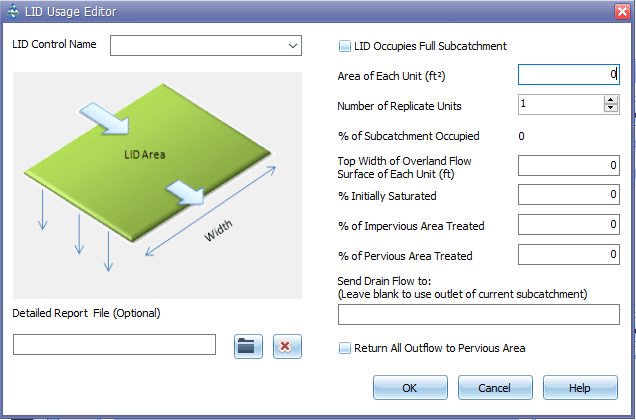C.14 LID Usage Editor

The LID Usage Editor is invoked from a subcatchment's LID Group Editor to specify how a particular LID control will be deployed within the subcatchment. It contains the following data entry fields:
-
Control Name: The name of a previously defined LID control to be used in the subcatchment. (LID controls are added to a project by using the Data Browser.)
-
Number of Replicate Units: The number of equal size units of the LID practice (e.g., the number of rain barrels) deployed within the subcatchment.
-
Area of Each Unit: The surface area devoted to each replicate LID unit (sq. ft or sq. m). If the LID Occupies Full Subcatchment box is checked, then this field becomes disabled and will display the total subcatchment area divided by the number of replicate units. The label below this field indicates how much of the total subcatchment area is devoted to the particular LID being deployed.
-
Top Width of Overland Flow Surface: The width of the outflow face of each identical LID unit (in ft or m). This parameter only applies to LID processes such as Porous Pavement and Vegetative Swales that use overland flow to convey surface runoff off of the unit. (The other LID processes, such as Bio-Retention Cells and Infiltration Trenches simply spill any excess captured runoff over their berms.)
-
% Initially Saturated: For Bio-Retention Cells this is the degree to which the unit's soil is initially filled with water (0 % saturation corresponds to the wilting point moisture content, 100 % saturation has the moisture content equal to the porosity). The storage zone beneath the soil zone of the cell is assumed to be completely dry. For other types of LIDs, it corresponds to the degree to which their storage zone is initially filled with water.
-
% of Impervious Area Treated: The percent of the impervious portion of the subcatchment's non-LID area whose runoff is treated by the LID practice. (E.g., if rain barrels are used to capture roof runoff and roofs represent 60% of the impervious area, then the impervious area treated is 60%). If the LID unit treats only direct rainfall, such as with a green roof, then this value should be 0. If the LID takes up the entire subcatchment then this field is ignored.
-
Send Outflow to Pervious Area: Select this option if the outflow from the LID is returned onto the subcatchment's pervious area rather than going to the subcatchment's outlet. An example of where this might apply is a rain barrel whose contents are used to irrigate a lawn area. This field is ignored if the LID takes up the entire subcatchment.
-
Detailed Report File: The name of an optional file where detailed time series results for the LID will be written. Click the (
) button to select a file using the standard Windows File Save dialog or click the delete ( )button to remove any detailed reporting. The detailed report file will be a text file that can be easily opened and viewed with any text editor outside of GeoSWMM.
)button to remove any detailed reporting. The detailed report file will be a text file that can be easily opened and viewed with any text editor outside of GeoSWMM.
